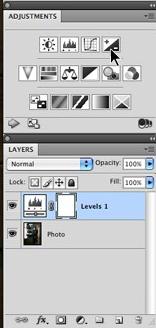
New Adobe Photoshop CS4 has just been released (23rd Sep 2008). Even though it looks similar to CS3 there are lot of improvements. It has nicely evolved from CS3 incorporating quite a few new features. Here are few features I liked in Adobe Photoshop CS4.

To make work flow easier Adobe Photoshop CS4 now adds not just existing core adjustment features such as Levels, Hue/Saturation, Exposure, Black and White, Channel Mixer, Selective Color, Color Balance, Photo Filter, but a completely revised version of the Curves feature and a brand new Vibrance adjustment tool. All of them are now presented in a single panel which will provide both efficiency and quality gains way beyond the effort needed to get over the initial hump in the CS4 learning curve.
Graphic card powered display
Photoshop CS4 makes use of the awesome power of the modern graphics card to help display pixels on screen. Users with graphics card containing at least 256Mb of on board memory and a supported GPU will be able to take advantage of the changes which include:
- Fluid Canvas Rotation
- Smooth Accurate Pan and Zoom functions
- Animated Zoom and Toss (carrousal view) functions

Masks Panel
This new panel has dedicated sliders for altering the density and feather of a mask which in turn will change the strength of the masked effect and the softness of the mask’s edge. The powerful Refine Edge feature can also be accessed from the panel, along with the Invert feature that switches masked and unmasked areas.

Content Aware Scaling feature
You can now push and pull different image parts around the canvas and have Photoshop fill in the gaps. It is now possible to move, stretch and resize different sections of your photo at different rates. This is drastically different from the Free Transform command, which when used in conjunction with the Shift key always resizes all picture content at the same rate. The image is scaled by keeping detailed areas the same and up or downsizing the parts of the photo that are feature less.

Maximum depth of field
The layer auto-blending options in Photoshop gets an extra mode designed to combine photos of the same scene but with different focus points to create an image with extreme depth of field (DOF). The result displays the visual sharpness from the very front of the scene right into the distance. Using this new feature you can capture a series of images of a subject with a wide aperture, that typically produces a shallow depth of field effect, and combine the results to create a photo that combines the DOF of all source photos. This feature automatically color corrects the source files while blending as well.

Improved Photomerge
The feature can now create 360 degree panoramas, automatically detect source images taken with fisheye lenses and has a new Collage option which allows for rotation and scaling of source files as they are being montaged.
Adobe Camera Raw 5.0
Looking identical to the Lightroom 2.0 featurewise the new camera raw 5.0 gets the two key very popular localized adjustment tools found in Lightroom, the Adjustment Brush and Graduated Filter. Also new for this release is the ability to apply Vignetting changes to images after they have been cropped in ACR. This solves the problem of applying aesthetic darkening of a photos edge to only have the effect cropped, or worse, partially removed when the photo is cropped.
Integration with Lightroom 2.0
Now you can freely pass your Raw photos between Lightroom, Adobe Camera Raw and Photoshop with the changes being respected in each program. Lightroom 2.0 also includes more ways to pass photos to Photoshop. You now have the option to open a Lightroom managed file in Photoshop as an embedded Smart Object. You can also pass a series of photos to the Merge to HDR or Photomerge features.
Dodge, Burn and Sponge tools
Burn and Dodge get a new Protect Tones option designed to reduce the muddiness that plagued so much of their work previously. The Sponge tool comes back with the addition of a Vibrance switch which converts from making basic saturation changes to concentrating adjustments on pastel or desaturated colors.
Live Preview Cursor Tips
The Clone Stamp and Healing Brush now display a preview of the sampled image at the cursor tip. This provided the user with much needed visual information when trying to line up sampled image parts with background information during stamping actions.
Transformation of Smart Objects
In CS4 you can now apply Perspective transformations to a Smart Object. There is the ability to work with linked layer masks and sample the content of the layers within the Smart Object with the new Eyedropper tool.
3D Editing and Compositing
The new and enhanced 3D tools found in Photoshop CS4 Extended are designed to work with 3D images just as easily as the 2D pictures. New workflows allow you to interact directly with 3D models and easily composite these models within 2D scenes. Users are now able to edit properties such as lights, materials and cameras, and in the process create high quality rendered images thanks to a new ray-tracing engine.
Enhanced Multimedia Capabilities
CS4 Extended increases the ease with which videographers are able to drag motion based images into Photoshop and provides them with more of the type of tools they need to work on these frames. Photoshop can now work more easily with non-square pixels, any audio associated with video footage, and it is also possible to animate 3d objects, camera position, render settings and even cross-sections.


Great post, thanks for the info
Rose Lovely puzzle site you have out there, thanks for dropping by
Regards
Krishna Mohna